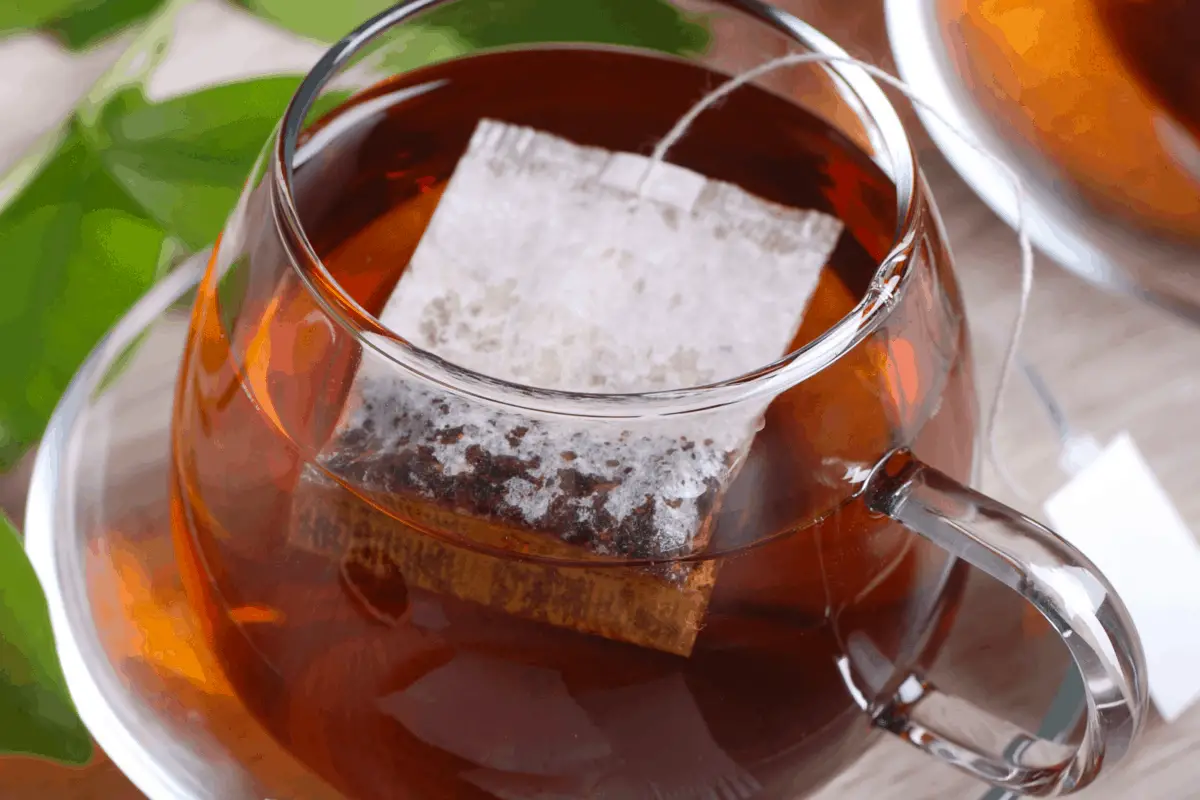Let’s face it. Microwave ovens, love them or hate them, have transformed how many people cook or warm food. The same is true for tea, and the practice comes with both controversy and questions. Microwaving water to pour over a tea bag or tea infuser is one thing, but actually heating a tea bag in the microwave is quite another. If you love using a teapot, but also may need to rely on a microwave now and then, or you routinely rely on your microwave for actually steeping tea and wonder if it is safe, then continue reading. I’ll cover the variety of opinions, questions, and research.
Tea bags can be steeped in a microwave oven. In fact, research indicates that microwaving a tea bag immersed in water releases more nutrients. The small staples on tea bags are generally safe for the microwave if they are immersed in the water.
While there is a debate as to whether microwaving tea bags is the “correct” way to steep tea, your personal preference really rules the day.
Believe me, I love traditions and long-standing cultural rituals. However, I also support creativity and innovation. The option to microwave tea bags (and actually reap health benefits as a result) lands in the “innovation” category for me.
Even though I don’t tend to microwave tea bags, I fully support everyone’s options to make that choice.
If you choose to go this route, you’ll also want to know which teacups are truly microwave-safe. Read my article Are Teacups Microwave-Safe? How to Know for detailed comparisons.
For now, let’s cover the top questions you might have about whether microwaving tea bags is healthy and safe.
Is Microwaving Good or Bad for Tea?
Studies suggest that microwaving the water used to brew tea can give you uneven results, but additional research indicates that microwaving actually release more nutrients.
However, before you come to the conclusion that it’s not okay to microwave tea bags, hold on.
Although tea connoisseurs may have a good rationale for brewing the perfect flavored cup of tea using only a teapot, there is more information to consider.
“Microwaving, as it turns out, has the unexpected result of unlocking and increasing the very benefits we are all looking for from our tea.”
TEA CROSSING
What Research Says About Microwaving Tea Bags
Although we all have our own preferences for brewing the perfect tasting cup of tea, what does microwaving tea bags do for the potential health benefits?
Studies that food scientist Dr. Quan Vuong conducted give us some interesting facts about microwaving tea bags. He’s spent years researching and building a database of information about the topic.
Let’s cover more of what Dr. Vuong’s reasearch uncovered.
Microwaving Positively Affects Tea
Vuong’s project revealed that microwaving tea bags actually releases health benefits.
In an explanation of his research, Dr. Vuong says:
“I focus on identification, extraction and purification of bioactive compounds from various natural sources, such as medicinal plants, native flora and marine materials, as well as from the waste generated by agricultural and food production.”
“Though these constituents typically occur in small quantities, they often have big impacts on our health. They have been linked with prevention of cardiovascular diseases, microbial diseases, diabetes, obesity and certain types of cancer. Currently, 45 per cent of all anticancer drugs are derived directly or indirectly from plant compounds.”
“In addition, as potent antioxidants, these compounds can prevent microbial growth, minimise the lipid oxidation, thus they have been fortified in foods to extend the shelf-life”.
Dr. Vuong began with a project that could “produce safe, cheap and effective methods for the production of decaffeinated green tea and tea powder extracts.”
Here is what he found.
Microwaving Results in 5 Specific Benefits
Dr. Vuong’s research has demonstrated some very particular health benefits. Microwaving, as it turns out, has the unexpected result of unlocking and increasing the very benefits we are all looking for from our tea.

Research has revealed 5 very specific benefits:
- It increases the strength of the antioxidants in the teas by extracting bioactive compounds, adding beneficial value to the tea.
- It makes tea taste better. Microwaving extracts, isolates and purifies certain substances that occur naturally in black tea and green tea. Microwaving activates up to 80 percent of the polyphenol, theanine, and caffeine compounds to deliver the best possible taste.
- The health benefits are greater for lowering hypertension, cholesterol, diabetes, and cardiovascular disease risks better. This is thanks to higher levels of polyphenols which are antioxidants.
- Microwaving tea bags can relax you more. It releases higher concentrations of the essential amino acid Theanine. This compound occurs naturally in tea and it helps to promote calmness and relaxation.
- You get the best health benefits when you drink at least 3 cups of microwaved tea a day.
Does Microwaving Tea Destroy Nutrients?
Most of us believe that microwaving anything will kill at least some of the nutrients in food.
The radiation used in heating the food sounds ominous, but it’s not a lot different than other methods of heating consumables.
Microwaving tea does not wipe out all of the nutrients, and it only decreases the value of some nutrients minimally, unless you heat it for too long.
The half power and 30 second method doesn’t destroy nutrients. As I just mentioned, and according to Dr. Vuong’s research, it has the opposite effect by releasing more bountiful supplies of the beneficial compounds that help to improve your health.
While some nutrients are more heat sensitive than others, those found in tea are resilient and they open up nicely in a microwave when heated as directed.
What are the Best Steps to Microwave Tea Bags?
Now that you know that microwaving tea bags might actually be beneficial, let’s cover the specific steps to help achieve the best results.
Tea purists will completely shun this practice, but what if you don’t have a teapot or just find yourself in a hurry now and then?
If you decide to microwave, here are 3 steps for getting the best results:

- Fill the cup with hot water, and your teabag
- Set the microwave on half power, then heat for 30 seconds
- Allow the tea to sit for one minute to complete the brewing process.
Can You Make Loose Leaf Tea in a Microwave? 5 Simple Steps
You can make loose leaf tea in a microwave, but the process is a little different than microwaving a cup of water with a teabag.

Here are the recommended steps for microwaving loose leaf tea for the best results:
- Measure 1 to 2 tablespoons of water into a microwave-safe cup or mug. Add the desired amount of tea leaves to give you the strength you like best. Do not use a tea infuser.
- Set the microwave on half power, place the mug inside, and heat for 30 seconds.
- Cover the mug with a napkin and let the heated tea sit without disturbing it in the microwave for approximately 2 minutes.
- Take off the napkin and take the mug out of the microwave.
- Remove the tea leaves. You can strain the tea through a tea strainer if any tea leaves remain.
Why Does Microwaved Tea Taste Different?
If you compare the taste of microwaved tea with the taste of kettle-brewed water poured over tea bags, you may notice a difference.
The most common reason given is that water may heat at an uneven temperature in the microwave.
Some studies suggest that this theory may not be accurate while others insist that it is a fact.
The tea flavors are released best when hot water reaches a temperature that is slightly under the boiling point. It releases the compounds that give it a rich and bold flavor and body, while water that is cooler in spots and too hot in other areas may produce a weaker or bitter taste.
While water temperature and the duration of the brewing time absolutely affect the flavor of tea, other factors make a difference as well. For example, tea will absorb flavor from the kettle metal.
Considering the brewing process and every factor involved in achieving certain flavors, even the smallest differences in the brewing process can alter the taste of the beverage. Each brewing method will have a different effect on the compounds and will produce a subtle difference in aroma, body, and flavor.
Can You Microwave Tea Bags that Have Staples?
This is another frequently asked question and the answer depends on who you ask.
The staple used to hold the bag to the string and tag is small. However, as we all know, metal that is exposed in a microwave deflects the waves that cause molecules to move and bump into one another. This can result in sparks.
If the staple is completely submerged in water, the liquid absorbs the sparks and it’s not likely to cause damage.
It’s probably not worth taking the chance that the staple will move to an exposed position in the cup, though. Although even a dry staple is small and it isn’t likely to cause a fire, it’s still not a great idea. It could potentially cause some serious damage, according to researchers and experts at the University of Illinois.
However, people have microwaved tea bags with staples for decades.
This is one of those questions that calls for an understanding of what could happen, along with the probabilities, and making the choice of how lucky you feel.
The odds for a safe outcome are actually in your favor if you keep the staple under water.
Are There Any Reasons You Shouldn’t Microwave Tea?
There are plenty of opinions as to why you shouldn’t microwave tea.
While any negative research about microwaving tea bags may be valid, it appears that the benefits far outweigh the potential disadvantages when it is done correctly.
Ultimately, this decision probably comes down personal preference.

However, here are the main reasons given against microwaving tea:
- You can’t achieve the ideal water temperature
- Microwaving a tea bag with a staple is not 100% safe because of the small metal piece
- Microwaving changes the flavor
- Pockets of heat can cause the water to explode
So, if you love using a teapot, but also may need to rely on a microwave now and then, or you routinely rely on your microwave for actually steeping tea and wonder if it is safe, I hope you have some newfound confidence.
And, whether you choose to stay entirely with traditional means of steeping tea, or you decide to incorporate your microwave as an option, trust me, we can still be tea friends.

